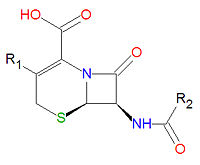Cephalosporin
cephalosporins are a class of antibiotic compounds sharing a common base structure, 7-aminocephalosporanic acid (7-ACA), that was derived from the first cephalosporin discovered, cephalosporin C. Penicillins are very similar, although they contain a five-membered ring in place of the six-membered ring present in the cephalosporin. The activity of cephalosporins, penicillins, and some other antibiotics are due to the presence of a beta-lactam, which binds irreversibly, via acylation, to penicillin-binding proteins, thereby inhibiting the peptidogycan layer of bacterial cell wall synthesis. Cephalosporins are often made semisynthetically. Cephalosporins and cephamycins are collectively referred to as cephems.
First generation cephalosporins
- Cefacetrile
- Cefadroxil
- Cefalexin
- Cefaloglycin
- Cefalonium
- Cefaloridine
- Cefalotin
- Cefapirin
- Cefatrizine
- Cefazaflur
- Cefazedone
- Cefazolin
- Cefradine
- Cefroxadine
- Ceftezole
Second generation cephalosporins
In general, second generation cephalosporins have a broader spectrum of activity against Gram-negative bacteria.
